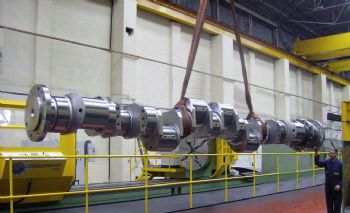Large-capacity orbital grinding
Posted on 12 May 2010. Edited by: Machinery Market. Read 2725 times.

Lincoln Crankshaft & Machine Ltd recently took delivery of an orbital shaft and crankshaft grinding machine. Managing director Mick Harwood says: “We have grown our sub-contract shaft and crankshaft business over the years, and 2009 was our best trading year thus far. As part of our on-going strategy, additional investment in new plant and equipment was required in order to achieve the next stage of our company development. We looked closely at the global market for a suitable machine, then discovered that Broadbent Stanley was in the final stages of development of a large-capacity orbital grinding machine — just what we needed.”
Orbital grinding is not a new process, but machines as big as the Orbigrind, which has a maximum distance between centres of 11,000mm and a swing of 1,900mm, had proved difficult to produce and suffered from wear in the ballscrew/drive, caused by constantly reversing a cross-slide/wheel-head assembly weighing up to 8 tonnes. So a completely new drive system was developed, using linear-motor technology. Although this is more expensive, it eliminates the need for conventional drives and gives micron accuracy.
LCM has achieved major savings in both set-up and machining times with its new machine. “Once fully proficient,” Mr Harwood says, “we believe we can slash up to 60% off setting times alone. This will give us better throughput, and a reduction in lead time, which in turn will make us more competitive in the market-place.”
LCM was founded eight years ago, out of the ashes of Clark Crank & Forge Co, and specialises in one-off and small-batch production of shafts and crankshafts up to 11m long. The company achieved a turnover of £150,000 in its first year; last year’s figure was almost £9 million.